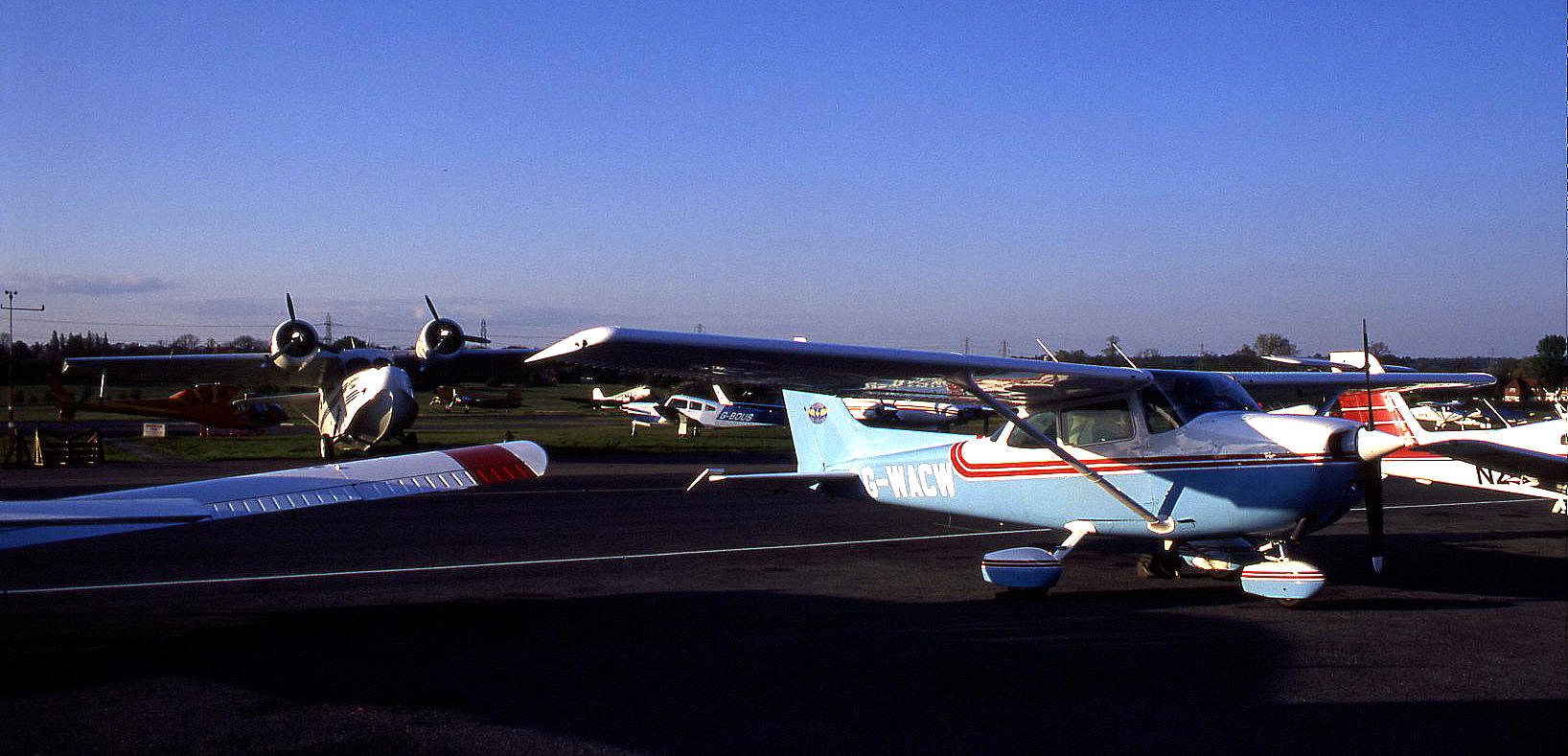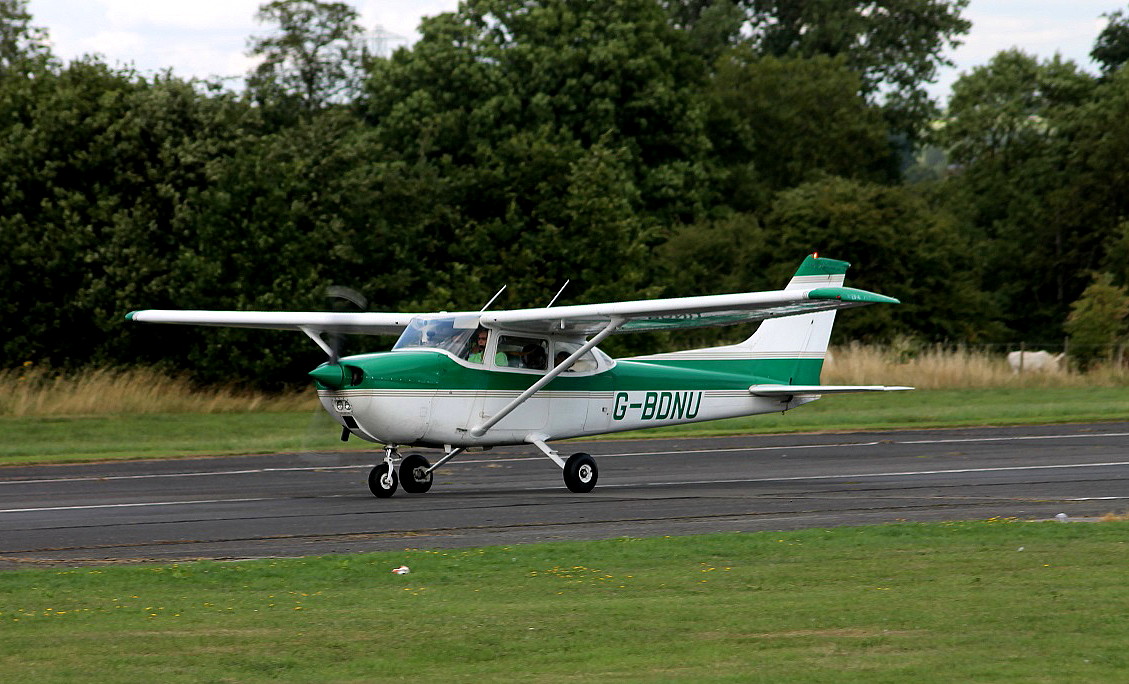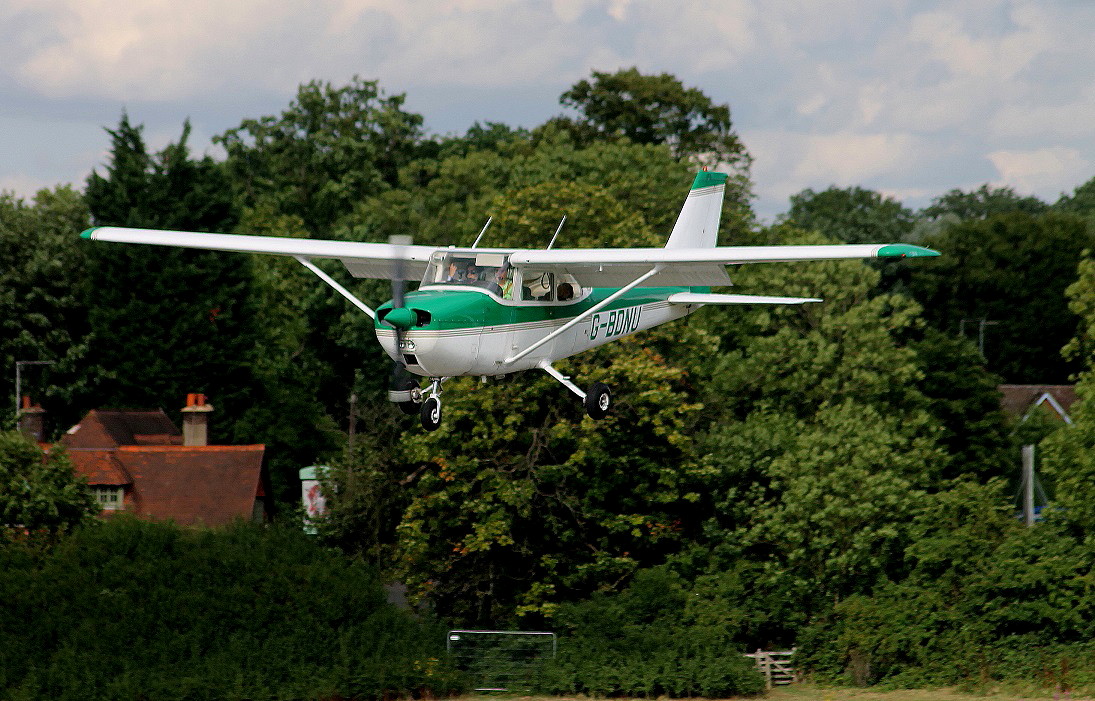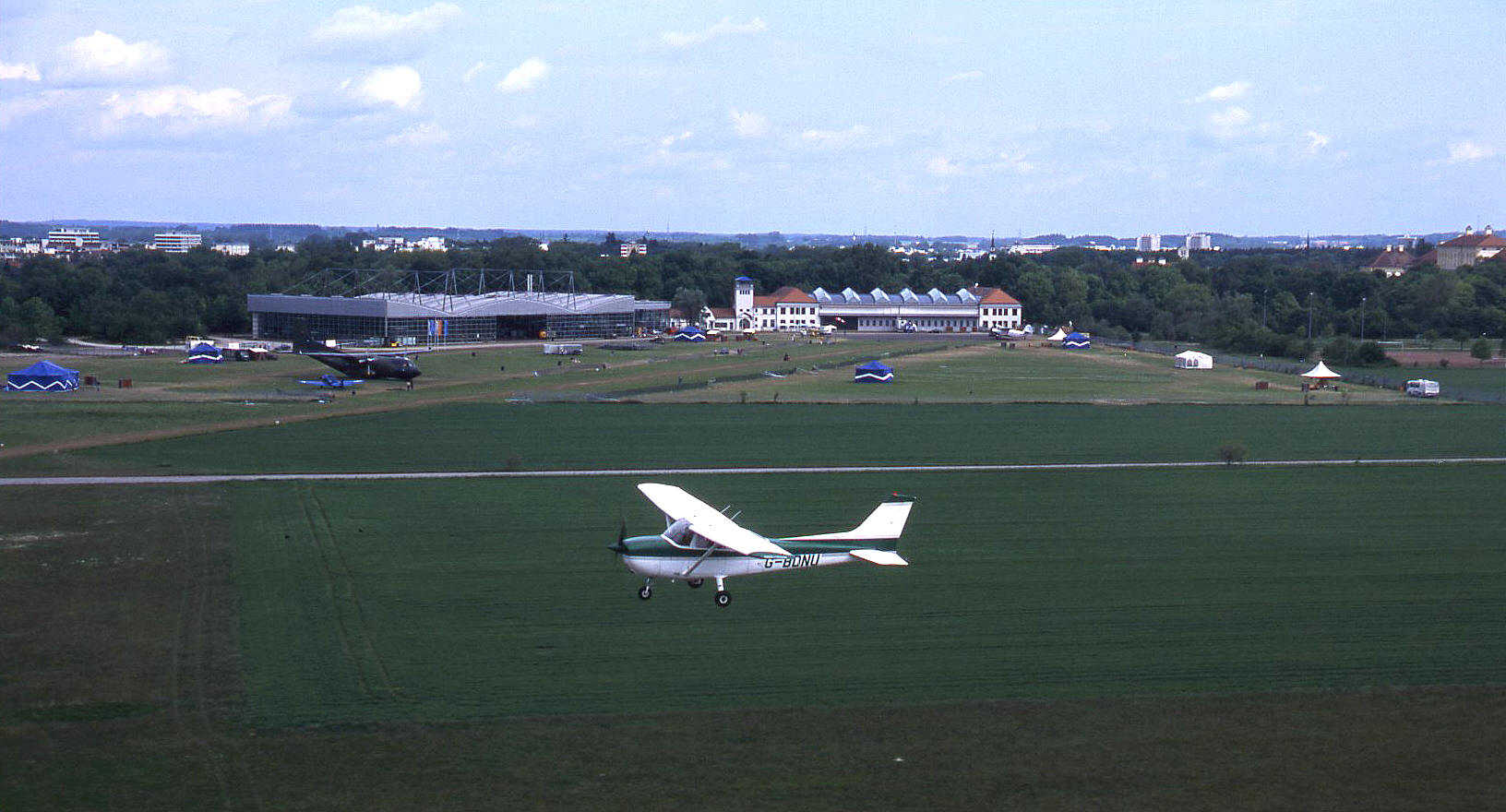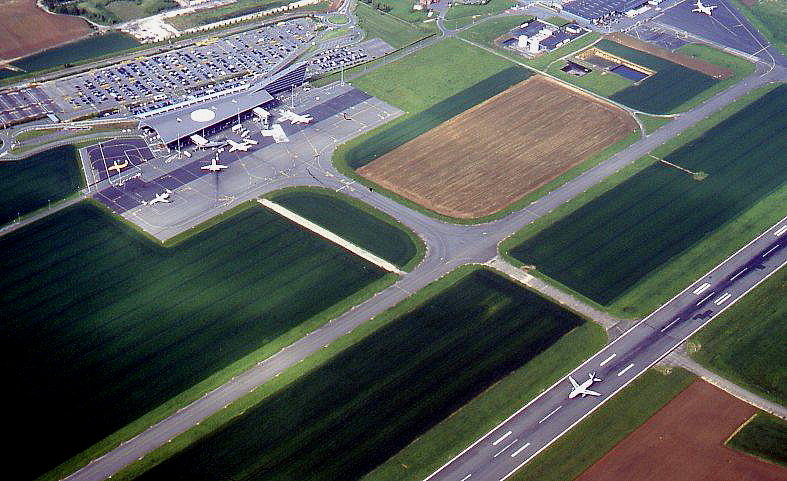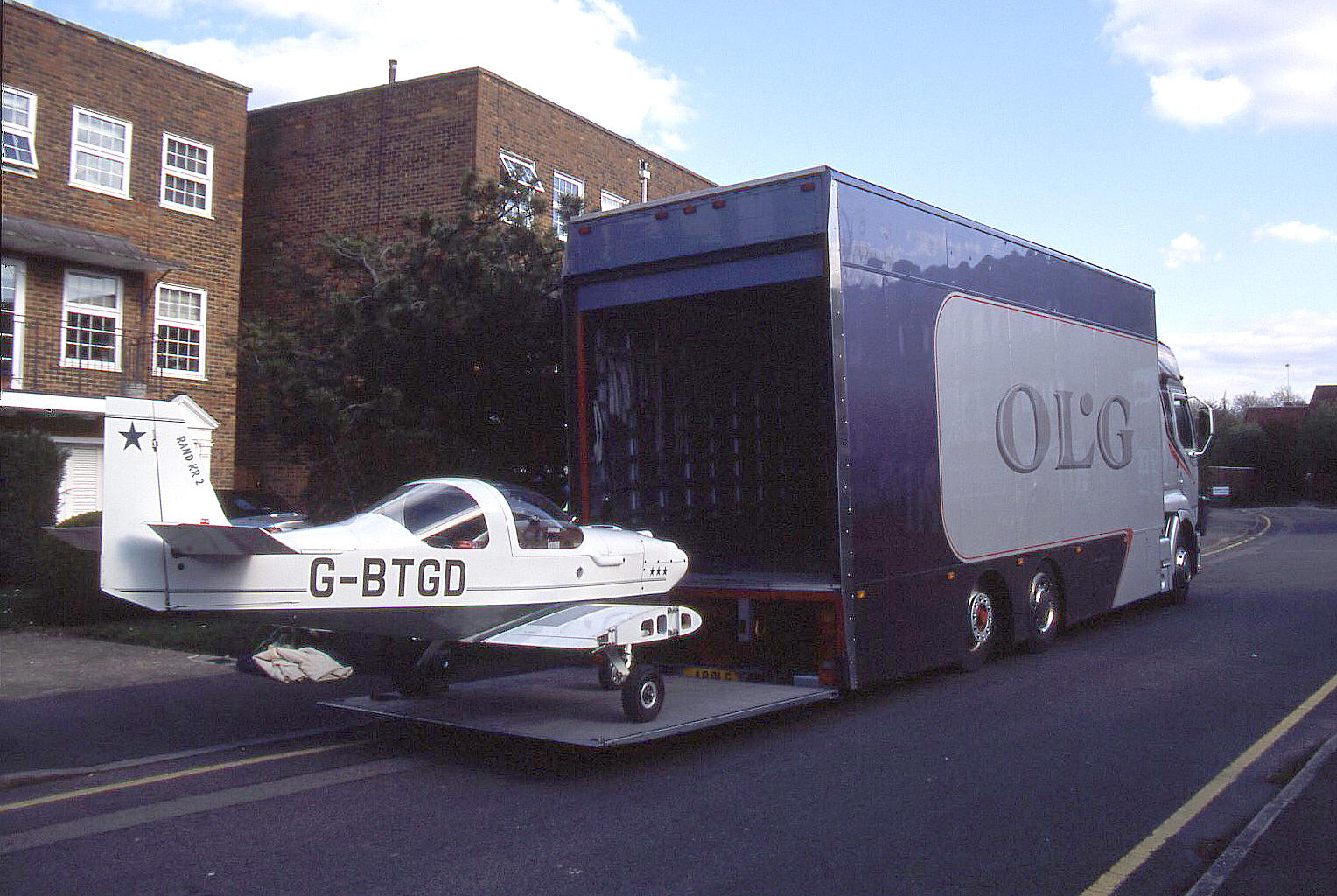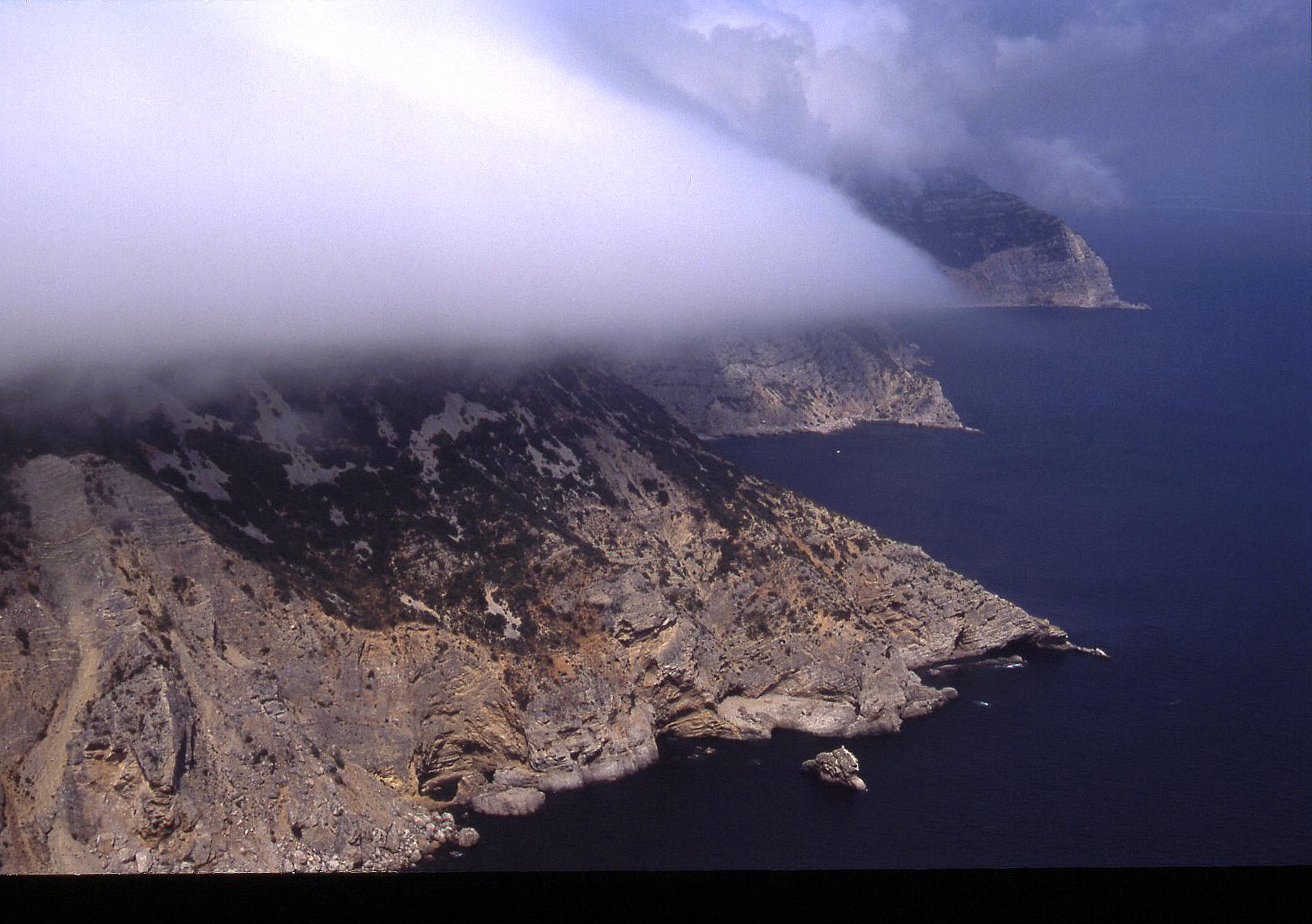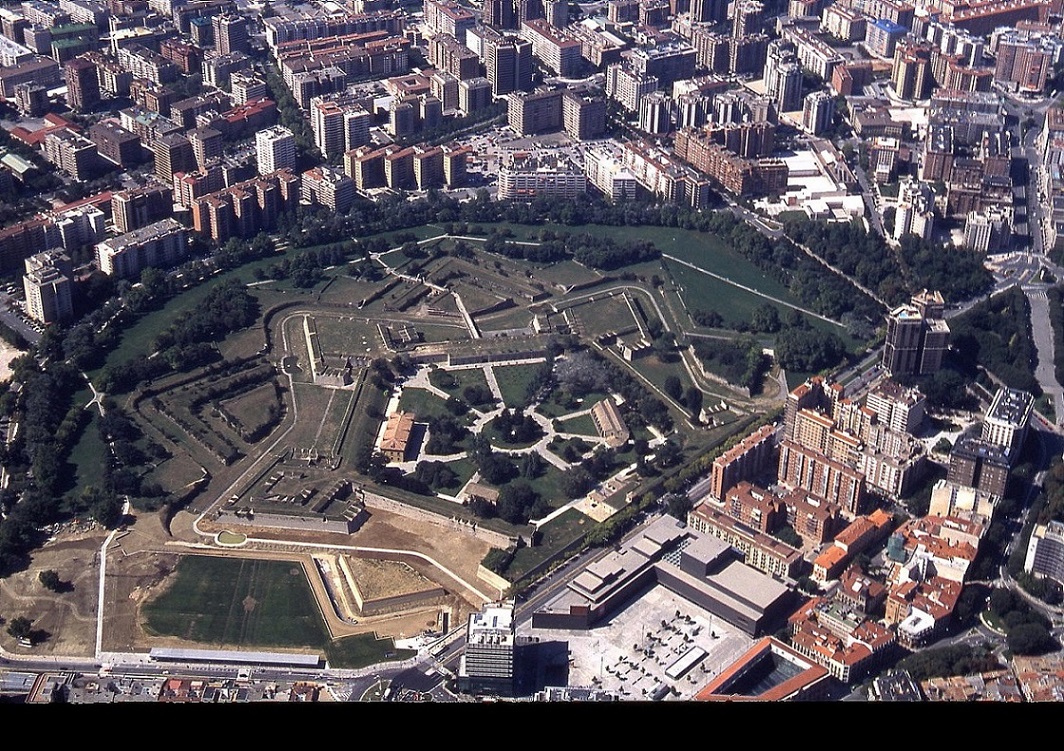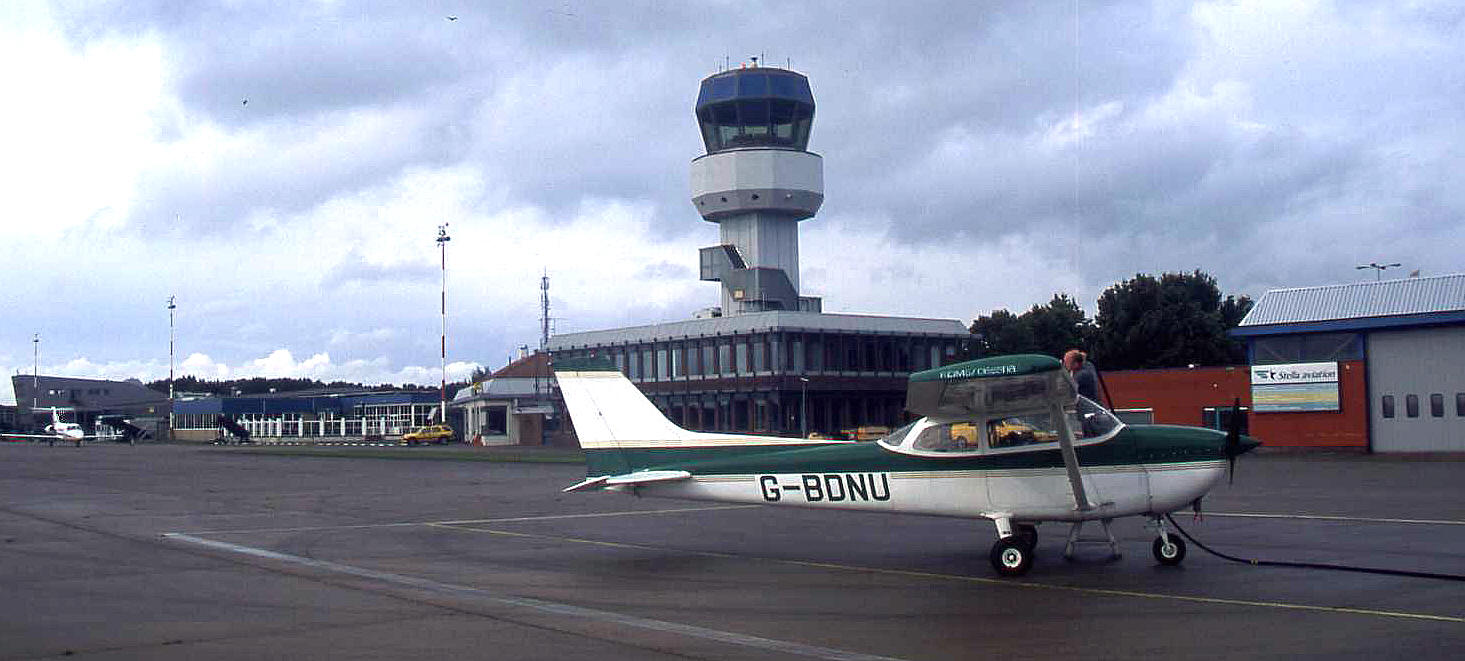Elstree
ELSTREE: Civil aerodrome
(Previously ALDENHAM COUNTRY CLUB & HAM FARM, also known simply as ALDENHAM)
Note: All pictures by the author unless specified.
*NOTE: The Cougar G-AFLII was used by the Capital fm radio station to provide traffic reports around Greater London. I often saw it when driving around London and the pilot (or pilots) seemed to be having a great time performing steep turns. I once wrote an article about radio traffic reporting (around this time as it happened) and enquired why the use of aircraft appeared to have ceased in England. The answer was that there were now far too many major traffic problems for aircaft to cope with.
Fourth picture: This delightful period picture from a postcard, (tinted from a black & white photograph) shows three classic aircraft from the late 1950s. The picture was kindly sent by Mike Charlton who has an amazing collection. See, www.aviationpostcard.co.uk
In the foreground is the Miles M14A Hawk Trainer 3 G-AKKR. Then privately owned, it was from 1953 to 1957 registered to Wolverhampton Aviation, Municipal Airport, Codsall.
To the left is the Auster J/IN Alpha G-AGTP, which was written off as destroyed on the 16th June 1978. Beyond that is the Piper PA-22-160 Tri-Pacer G-ARGL which appears to be a visitor, possibly flown in by a member of the Roses Flying Group? Either way this aircraft was based in Cheshire during this period. However, this picture is also indicative of the period when American imports would soon dominate the UK General Aviation scene.
Operated by: Late 1940s: Mr Wilkinson
Since 1965 certainly(?): Montclare Shipping Company Co Ltd
Activities: GA air taxi, charter, maintenance, private, training
Charter/air taxi: Airborne Taxi Services, Atlas Aviation, Cabair, LAMS, Polyfoto Air Taxis
Aerial survey and photography: Aerofilms, Derby Aero Survey, Hunting Aerosurveys, Photoflight, Polyfoto Air Taxis
Note: In the 1957 'The Aeroplane' directory, Aerofilms had two Austers based here, as a Hunting Group Company.
However, the entry for Hunting Aerosurveys, (presumably including Aerofilms?) presents a much bigger picture. Their remit is given as: "Vertical and obique air photography, photogrammetric mapping and map revision, precision model makers." Their fleet was: Three Austers, one DH89A Dragon Rapide, one Airspeed Oxford, one Avro Anson, three Percival 'Survey' Princes and last but certainly not least, one Douglas C-47 Dakota.
Would it be fair to assume, with their considerable facility in nearby Borehamwood, that they drew quite heavily on the expertise and indeed people, released from the RAF photo-reconnaissance activities in WW2? Another associate company was Hunting Geophysics, "Specialists in airborne geophysical services".
Also listed in the 1957 'The Aeroplane' directory is Photoflight. Can anybody kindly offer advice?
Flying club/schools: Post 1945: Air Schools, American Flight Academy, Cabair Flying Schools, Elstree Flying Club, Firecrest Aviation, Flyteam Aviation, Handley Page Power Flying Club, Lion Flying Group, London Aero Motor Services, London School of Flying, Skysport UK, Ultra-Light Aircraft Association
In the 1957 The Aeroplane directory, Elstree Flying Club were listed as operating four Auster J/1 Autocrats, four Miles Hawk-Trainer 3s, one DHC.1 Chipmunk and one Miles Gemini. Would I be correct in thinking that in 1957 very few civil Chipmunks were knocking around in the UK?
1959 ‘snapshot’: Aldenham Private Flying Group, Elstree Flying Club, LCW Group, Middlesex Flying Group, Mill Hill Group, MPM Flying Group, North Middlesex Flying Group, Roberts Eagle Flying Group, Swallow Flying Group, Westbourne Flying Group
Gliding club: Aerotec Gliding Club (1947 to 1949 only?)
Helicopter ops: Cabair Flying Schools
Maintenance: Cabair
Manufacturing: Fairfield Aviation, London Aircraft Production Group
Location: 0.5nm NE of A41, 3 nm E of Watford
Period of operation: 1930s to present day
Note: These maps are reproduced with the kind permission of Pooleys Flight Equipment Ltd. Copyright Robert Pooley 2014. Pooleys are based at ELSTREE and have their offices and shop on the airfield.
Runways:
1965: 09/27 663x27 hard 04/22 518x91 grass
2000: 08/26 656x30 hard
ELSTREE PICTURES
Note: The Robin R-3000 was, I believe, the only all metal four-seater type produced by the company, and was not a commercial success - selling very few. This said, Lee Merritt who produced this web-site once owned one and has a very high opinion of the type. Without much doubt it could out-perform all the American types of a similar specification and design, so one wonders what the problem was?
TWO 'DAKS' AT ELSTREE
Note: Several years ago I made this comment: "Why is it that these two 'Daks'came to be based, and/or stored here in early 1997? It appears to be something of a mystery? In early 2017 Jose McVicar of the Lion Flying Group, of which I was a member, told me that a chap called Bob King was involved in 'wheeling and dealing', purchased these 'Daks' and decided to put them into open storage at ELSTREE.
This was of course during a period when there was considerable interest in the film industry for making films about the latter stages of WW2, and the Douglas C-47 Skytrain (the RAF named them Dakotas) was a firm favourite for flying 'shots'. However, does anybody now know what became of these two 'Daks'?
NOTES: The address for the fourth venue of Alan Cobham’s 1933 No.2 Tour is ‘Aldenham Country Club, Ham Farm, Elstree. It appears this is where the original ELSTREE aerodrome started.
MS. BERYL MARKHAM
It is probably not much appreciated today that Ms Beryl Markham had taken up residence at the Aldenham Country Club whilst extensive preparations were being made for her attempt on the first East-West trans-Atlantic flight from England. She regularly flew from ELSTREE to GRAVESEND (KENT) to inspect the Percival Vega Gull VP-KCC (‘loaned’ to her by Lord Carberry) being prepared. For some obscure reason RAF ABINGDON in BERKSHIRE was chosen as the departure point. When the day of the record attempt came Ms Markham flew from ELSTREE to ABINGDON before departing across the Atlantic. Consequently, when she crash-landed out of fuel on Cape Breton Island near Sydney, she had been awake 40 hours!
This wasn’t so long ago, just seventy years, but it wasn’t until thirty years later that serious studies emerged regarding fatigue factors in human behaviour. Indeed, it was commonly believed that sheer guts and determination could overcome fatigue for days on end if needed. Today of course we recognise that only a very few, subjected to extreme training regimes, can even hope to cope.
FAIRFIELD AVIATION
Although not strictly speaking a manufacturing company Fairfield Aviation undertook extensive modification work on Vickers Wellingtons and Westland Lysanders, the latter for Special Operations. They also carried out work on a variety of other types, including Bristol Blenheims, Hawker Harts and Miles Masters. In total 1,809 aircraft were worked on, mainly comprising 473 Wellingtons and 1,217 Lysanders.
LONDON AERO and MOTOR SERVICES
London Aero and Motor Services (LAMS), certainly deserves a mention. This operation was formed at ELSTREE in 1946 by Dr Graham Humby, (a plastic surgeon with many varied business interests), using converted Handley Page Halifax bombers as freighters but they moved the operation to STANSTED in December 1946. He subsequently had a fleet of over forty Halifax freighters on world wide operations. LAMS also operated a flying club here and one of their Austers featured in a highly novel murder case when Donald Hume hired it to drop the “parcelled” body of Stanley Setty over the Thames Estuary. This sounds to me an incredibly difficult feat to accomplish… unless he removed the door on the passenger side?
THE ULAA
It was also at ELSTREE just after the end of WW2 that the Ultra-Light Aircraft Association was formed before moving to REDHILL (SURREY) in 1950. The ULAA was of course the precursor to the PFA (Popular Flying Association) and now the LAA (Light Aircraft Association) and it is well worth reading up on the enormous amount of problems the ULAA had to overcome of a practical and financial nature. Plus of course, the numerous encounters with the drab and dusty denizens who then inhabited the dreary world of officialdom and who seem to have regarded anybody foolish enough to even contemplate building their own aeroplane as having serious mental health issues. Or, to use an old-fashioned expression, stark raving bonkers! The ULAA in those early days at ELSTREE seems to have had a very distinct nature in as much as they jointly possessed several aircraft, (also several more in various stages of construction), but rarely more than one capable of actually flying, and even then a couple of examples which had a climb rate best measured on a calendar.
WHY DO PEOPLE FLY?
One aspect of flying, often overlooked, is why people fly. There are more reasons than can possibly be described, but here is one I found interesting in the book British Midland Airways by B G Cramp published in 1979. This refers to the DH.85 Leopard Moth ‘company hack’ G-ACLL then operated by Derby Airways, the time frame being 1964. “…. “LL” had only been used spasmodically by the Directors and a little more frequently for positioning aircrews and spare parts around. Now the new Commercial Manager (Captain B G Cramp) found the aircraft of increasing value in the making of business calls which were outside the Company’s own service network. He could often be seen flying the Leopard Moth to STAVERTON, Bristol (LULSGATE), Cardiff (RHOOSE), Birmingham (ELMDON), and even to London where he would land at Elstree (My note: Remember the Flying Training Division of the Company was based here), and then cadge a lift or a taxi to the nearest Underground station and so into the City.”
A FAMOUS ACCIDENT
The famous Formula One racing driver Graham Hill died nearby in July 1975 trying very foolishly to make a landing here in fog. Any half decent and well trained pilot wouldn’t have attempted it, but the rich and famous do seem to think they abide on earth by other rules and quite rightly often pay the ultimate price for their stupidity and arrogance. Graham Hill was, as a pilot, a fool at best, and not a nice person by all accounts, (despite his prowess on the race track), and needlessly killed four others in his team in this most stupid if not suicidal attempt to land at ELSTREE. A diversion to LUTON, a few miles north with full ATC facilities, would almost certainly have been successful. Assuming of course that Mr Hill was fully instrument rated.
A RIDICULOUS SOLUTION
In the early years of the 21st century, attempting to alleviate aircraft noise & complaints levels, ELSTREE introduced one of the most complex circuit procedures ever introduced at a UK aerodrome. It proved to be untenable and certainly did nothing to improve safety. It was dropped in favour of an altogether better, simpler and much safer arrangement but it does go to prove that local pressure groups can force airfields into adopting highly unsuitable and even unsafe practises. For example I have seen, (in a flight guide), a circuit in Germany that described a figure of eight over the airfield!
A BIT OF A FLOP
On the 17th April 1997 it was arranged that I would fly the camera plane, (the Cessna 172 G-WACW), from Wycombe Air Park to Elstree for Austin J Brown to photograph the Kragug, a very rare type in the UK, a Yugoslavian produced basic ground-attack type aircraft, for Flyer magazine. Initially it all went well, and an arrangement had been made with ATC at White Waltham to do a low pass to simulate a 'ground-attack', and get appropriate pictures.
Unfortunately the radio in the Kragug was rubbish and the pilot had not understood the basics of the breifing and didn't follow through. I set myself up for, in a 172, a very low pass, at around Vne, and a sharpish pull-up along the active runway. Which was applauded by ATC - except there was no Kragug following behind!
Having landed at White Waltham, we decided not to try and repeat the exercise, and the Kragug followed us back to Elstree so that a photographer from Aeroplane magazine whom Aussie had inivited along, could take his pictures.
A MOST REMARKABLE FLIGHT
In the October issue of Light Aviation magazine, this story was told. In 2018 the Scintex CP1310-C3 G-ASMV had been restored, and the owner and restorer David Hammersley had added, to its tail a tribute to a previous owner, Ken Vos.
As David recounts: "In 1964, having owned 'MV for less than a year Ken flew her single-handed and without publicity or support from Elstree , Hertfordshire, to Darwin, Australia. He had no ground crew or modern aids, just a map, compass, stopwatch, VHF radio, VOR and perhaps a Bendix ADF."
He left ELSTREE on the 30th September 1964 and arrived in Darwin on the 24th October. Just over three weeks - a remarkable achievement!
THE AERODOME CLOSED
In mid July 2010 a notice was posted that ELSTREE aerodrome is closed until further notice. A most extraordinary situation and, I think, unprecedented for an aerodrome near to London? This caused a great deal of consternation until common sense prevailed and it was realised the closure was only temporary to enable work to done on the runway!
PERSONAL MEMORIES
When South Cambridgeshire Council decided to close down every airfield in their region, except for CAMBRIDGE and DUXFORD, I was flying from TOP FARM. Explaining this dilemna to a friend, Simon Gadd, he inivited me to join the Lion Flying Group at ELSTREE where he was a member. The CFI (Chief Flying Instructor) and owner, Jose McVicar was a treat to fly with and never put a foot wrong, insisting on the best possible standards and attention to detail. And, perhaps I should add, I have flown with well over a hundred different instructors - probably more like two hundred.
Anybody who has learnt to fly with Jose is a very lucky person. I am still a social member of the Group and have many happy memories of flying their principal aeroplane, the Cessna 172 G-BDNU, on several memorable flights across Europe.
LION FLYING GROUP PICTURES
PICTURES FROM TRIPS IN G-BDNU
This is of course a bit of self-indulgence, but, I trust you might find it interesting? It reflects, (and I hope you will agree), how many private pilots depart our shores to explore further.
MAY 2003. THE TRIP TO OBER-SCHLEISSHEIM (MUNICH)
A friend who flies from Ober-Schleissheim had arranged for me attend an airshow, a 'one-off' event for 2003, to celebrate the 'official' birth of powered flight by the Wright brothers in the USA. That event in 1903 was a complete travesty arranged by the Wright brothers of course, but a damned good excuse for visiting Ober-Schleissheim which rarely invites visitors. On this trip I had Marleen van Cleef, a low hours PPL (but keen as mustard) and Jim Munro who had never flown in a light aircraft before. On landing at Luxembourg International Airport we received the news that we couldn't land at Ober-Schleissheim as a German goverment minister had decided that parking aircraft on the grass would be an environmental disaster, and he was flying down to take charge. After a few negotiations we arranged to fly in before the aerodrome opened, taking a night stop at Nördlingen where a beer-fest was happening - so no fuel available. And no sleep either in our hotel!
We arranged for Marleen to have a room at the back of hotel, so she could fly us to Ober/S, just after dawn the next day. The weather throughout Europe was dreadful and most of the aircraft intending to visit didn't arrive. We were commended for being the aircraft that had flown the furthest distance to attend this singular event. Afterwards, Jose was amazed how much fuel we'd taken on at Ober-S. It was a close run thing and we had to land on the first approach, (there wasn't enough for a go-around or missed approach), but with no wind at that time in the morning I had calculated we had just enough. And of course, nobody else was flying in the area, so it wasn't really much of a risk. As expected the navigation was a doodle, (who needs a GPS over much of Europe?), and the runway appeared over the nose.
NOTHING AMISS?
We'd checked the Met info before departing and nothing seemed amiss. Along the way flying back to Luxembourg in near perfect conditions, nothing was said to us when using the Flight Information service. Approaching Stuttgart we were confronted with an awesome sight; I had never seen anything so threatening, so I insisted we had to divert immediately into Stuttgart International airport. The response from ATC was immediate and exceptionally easy - we'd been flying towards the largest storm system ever recorded. Needless to say we spent the night there and the storm made front page news the following day. The remaining effects of the storm system the following day made our flight homeward somewhat problematical with heaps of clouds virtually on the deck. A call to ATC at Baden-Baden to route overhead and to remain clear of cloud resulted in an invitation to make a touch-and-go at this airport. There was torrential rain on the downwind leg so I took full advantage of this to fly through it to wash the aeroplane. Back at Elstree Jose couldn't believe how clean 'NU' was after flying as far as Munich.

MORE PERSONAL MEMORIES
In my other but main career running a transport company with my wife, albiet by this time reverting to being an owner-driver, I was tasked with moving the Rand KR-2 to ELSTREE in April 2007.
AUGUST 2007 A TRIP TO PORTIMAO ON THE ALGRAVE IN PORTUGAL
For my sixtieth birthday I decided we should fly down to Portimao to visit our daughter who was living and working on the Algarve. I had convinced my good friend James Roland to accompany us as I would do the easy bit, handlebar management and picture taking; and he could do the hard bit - navigation and radio. As per usual I cannot fly in straight lines so wanted to fly around the coast, (more or less), and then cut across country on the way home. It was a truly wonderful trip and what intrigued us was how very few other light aircraft were touring and seeing the fabulous sights to be seen in these regions of Europe.
We flew from Lydd to Nantes then onto Arcachon for a night stop. The next day was low level to Asturias, near the coast in central northern Spain. On the third day we flew to Santiago de Compostela which is a beautiful city but, as James pointed out, the way we were messed about by ATC made his task a lot harder than if he was flying a British Airways Boeing 767 in! (Which is his 'day-job' as a captain).
Extensive fog the following morning both delayed our departure and meant we couldn't fly around the extreme north west of Spain. Instead we had to fly south-west to Portugal and we followed the coast at low level to land at Cascais, near Lisbon. A feature of this sector was that the reporting point, Cabo da Roca wasn't on our Jeppesen chart but, having flown out of Cascais before I knew exactly where it was. I'd photographed it previously as it is the westernmost point of mainland Europe. The following day we again followed the coast to arrive at Portimao - a stunning flight. But, at Portimoa there was a howling wind blowing with a crosswind component and I was see-sawing on the controls like a man clinging to life - which actually is an accurate description thinking back. James of course told me me that if I had had another two degrees of left wing down - it would have been spot on. I was quite surprised to land 'NU' without incurring any damage.
PORTIMAO
We were surprised to see quite a few British aircraft here, but it appeared that none of them had flown around the coast, the preferred method mostly being to fly direct routes via VORs. We departed Portimoa in the afternoon to fly to Salamanca and the effect of thermals was astonishing. I did attempt for a short while to try and maintain a set altitude (as would be required in controlled airspace), but found it virtually impossible. One minute I had the power off, the nose right down and the ASI getting near to VNE (Never Exceed speed), and the next at full power in a climb at the best rate of climb speed. I was soon asked by James and my wife to desist, although I did suggest to James that he informed any contactable ATC service that we'd be 'level' at anywhere between 2,500 and 4,500 feet. His withering expression soon put me right on that score! However, it was great fun. Incidentally, I noticed that our departure the following afternoon to Pamplona was on the depatures board in the terminal. Fame at last perhaps but as James pointed out we'd missed a trick as we should have brought airline aircrew clobber to wear for escorting my wife to the Cessna 172.
HOMEWARD BOUND
From Salamanca we routed via Burgos to Pamplona for a night stop and the following day flew across the Pyrenees to meet up with the coast north of Biarritz which we followed at low level until just north of La Rochelle where we cut across to Saumur to refuel - which wasn't possible as they had a self-serve facility which only took one type of fuel card. A call to ATC at Angers confirmed they would happily allow us the shortest arrival possible as we really were quite short of fuel. After refuelling both the aircraft and ourselves we departed for Deauville where we landed after a Gulfstream which had flown the Atlantic containing George Clooney and another famous American actor (Brad Pitt possibly?) as there was an international film festival taking place. Needless to say the terminal terrace was packed full of screaming girls - but oddly I thought, apparently none of them interested in our arrival. Life is so unfair. The next day was equally glorious weather and we landed at Biggin Hill to clear Customs before returning to Elstree.
SEPTEMBER 2008. THE TRIP TO TEMPLEHOF
My very good friend James Roland (a senior BA Captain) and I had decided we had to visit Templehof before it closed forever. It was arguably one of the most iconic airports ever built in Europe, especially due to its involvement with the Berlin air-lift when it was used by the USAF. And, the terminal complex built in the 1930s is still rated as the second largest building in the world after the Pentagon in the USA. One major feature was that airliners could taxy into the terminal to get out of the weather.
We had appalling weather to overcome on the way out and only made it to Oostende on the first sector. But, we did make it through in 'one-hit' the next day. On the way back we flew first to Peenemunde, (famous for where the V.1 and V.2 were developed in WW2), and made a night stop in Keil. The following morning I flew 'NU' solo up to Sønderborg in Denmark to complete my objective of flying an aircraft in every country in western Europe - registered in each country. In the afternoon we had intended to fly to Antwerp in Belgium, via the Fresien Islands, but bad weather and very strong headwinds meant we had to divert to get more fuel. So, we landed at Groningen-Eelde in the Netherlands, before setting off again to Antwerp for another night stop in that lovely city.
AN END NOTE
On the 27th September 2009 I made my last flight as P.1 (Pilot-in-Command) from ELSTREE to BOSCOMBE DOWN, and that seems to me a fitting end for a PPL. Where else might you select? I don't think I was aware of this at the time, but that is how things panned out.
CAN YOU KEEP A SECRET?
I have so many fond memories of flying G-BDNU, a Cessna F172M Skyhawk built in 1976 at Prunay aerodrome south east of Reims, in northern France, by Reims Aviation SA. As you can see from the accounts above that lovely aeroplane barely missed a beat flying me, fellow pilots, family and friends around much of the UK and western Europe.
On the 3rd of October 2004 I flew November Uniform from Reims-Champagne airport to Prunay to fuel up. Our kind of fuel not being available at the airport. With a Mirage jet close behind, and a clearance to transit "Not above 500ft, and can you turn out as quickly as possible?" I needed no further encouragement, flying past the control tower at low level - great fun.
But, I have to confess and am now quite ashamed, that I did not realise until doing a bit of research for this 'Guide' many years later, the truth was that I was bringing November Uniform back to her birthplace. No cakes were baked, no candles lit, no bands were playing - she just sat there uncomplaining. Please don't tell anybody.
ANOTHER TRIP FROM ELSTREE
Following on from the mention above, this was during a trip to Charleville-Mezieres in September 2004 for a short holiday in the Ardennes. We landed at Lille to comply with Customs regulations and took full advantage of the excellent Met facility in the GA terminal. The entire region, in the Ardennes, was covered in low cloud - but- a small gap was moving slowly south. The most helpful ladies in the Met office provided hour-by-hour satellite pictures so that we could see how the gap was progressing, and it appeared to be consistent.
A simple calculation showed when this gap would appear over Charleville-Mezieres so we timed our take-off accordingly. Needless to say, we did have a couple of diversions in place if we'd messed up. In the event it worked out perfectly and was quite something to see. We approached to a straight in landing with dense cloud on either side, nobody else was flying, and within minutes the airfield was 'socked in', with persistent precipitation to boot leading to a damp trip to the taxi into town..
We'd love to hear from you, so please scroll down to leave a comment!
Leave a comment ...
Copyright (c) UK Airfield Guide



























